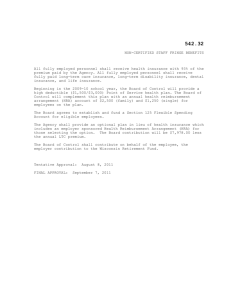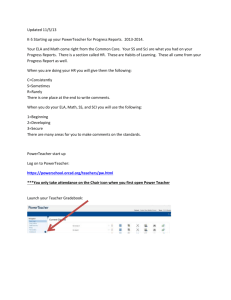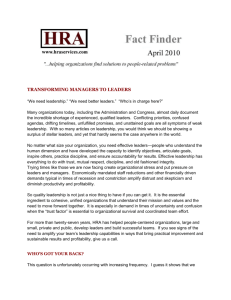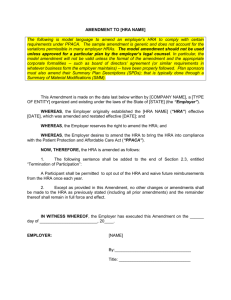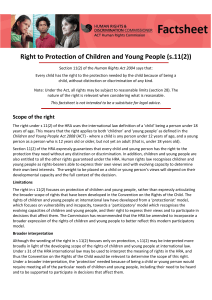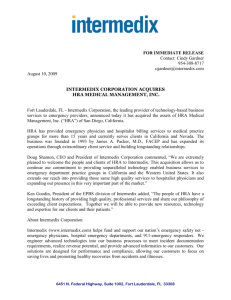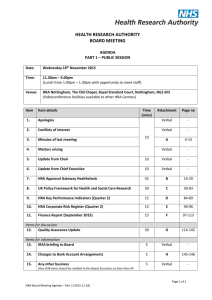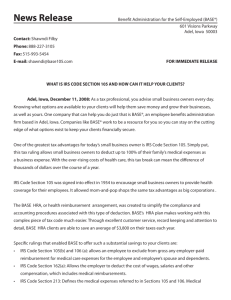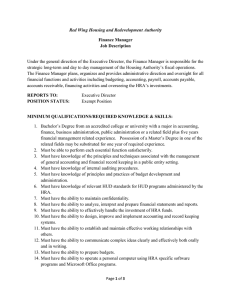Introduction to Health Reimbursement Arrangements "HRAs"
advertisement
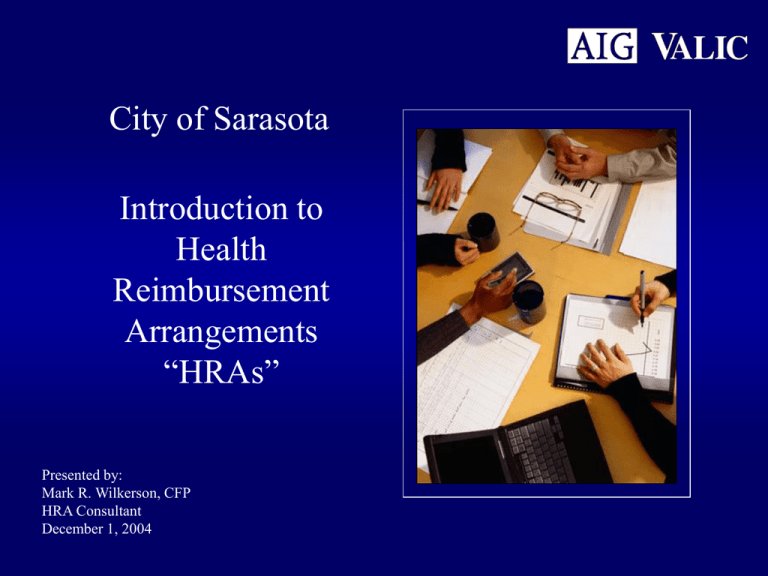
City of Sarasota Introduction to Health Reimbursement Arrangements “HRAs” Presented by: Mark R. Wilkerson, CFP HRA Consultant December 1, 2004 Topics HRA Team Group Structures & Voting Growing Need Contribution Requirements HRA Basics Employer Funding Sources HRA Advantages Aggressive HRA Plan Designs Eligible Expenses VALIC National HRA Plan Trust Structures Adoption Implementation and Ongoing Administrative Process HRA Service Team Combining: AIG VALIC - education and enrollment expertise and resources HRA Consultants - HRA experience Rehn & Associates, Inc. - HRA third party administration experience AIG VALIC Education Services Enrollment Services Special Pay Plan Companion HRA Consultants, a Division of VSG 21 years HRA consulting experience with governmental employers 7 trust clients Single or multiple employer plans 30,000+ participants 400+ employers Custom or turnkey plans Rehn & Associates, Inc. TPA with more than 40 years experience 11 years HRA experience 30,000+ HRA accounts 400+ HRA participating employers Employer billing services Individual participant services Claims adjudication Account service Statement generation Online participant account access COBRA Administration HIPAA Compliance Growing Need for HRAs (post-employment medical funding) Current Age Your Projected Total Cost @ 5% Increases 60 $247,893 55 $316,381 50 $403,791 45 $515,351 40 $657,733 The projections listed above are the amounts that a Washington retiree and spouse could spend during their lifetime assuming retirement at age 60, participation in the State of Washington PEBB Uniform Medical Plan, living a normal life expectancy to age 84, assuming purchase of medical insurance and dental insurance for retiree and spouse, plus annual out-of-pocket expenditures of $500 on non-covered items. We assume 5% annual increases for premiums and non-covered out-of-pocket costs. Current PEBB premiums before age 65 for retiree and spouse are $7,700 per year for medical insurance and $850 per year for dental insurance. Current PEBB Medicare supplement premiums are $3,500 per year for retiree and spouse. Monthly Growth Example What will my account be worth when I retire? Starting Age Monthly Employer Contribution Balance at age 65 w/ 5% return 25 $100 $148,856 35 $100 $81,870 45 $100 $40,746 55 $100 $15,499 $40,000 Cash-Out Without an HRA $40,000 available 25% federal income tax 7.65% FICA tax $ 40,000 Cash - 13,060 Taxes $ 26,940 Net Cash $40,000 With HRA Contribution $40,000 benefit available $ 40,000 Benefit 0 Taxes $ 40,000 HRA Balance HRA Basics Provide reimbursements of medical expenses only In-service and/or post-retirement Employer contributions only (no contribution limits) Reimbursements limited to account balance Carry forward from year to year IRS Notice 2002-45, HRAs Revenue Ruling 2002-41, HRAs Revenue Ruling 2004-45 – Coordinating HSAs, HRAs, & FSAs Employee/Participant Advantages Tax-free — Contributions — Earnings — Withdrawals for qualified expenses Excellent resource to pay the rapidly rising cost of postemployment health care List of qualified expenses is quite extensive Portable Unused balances carryover Allocated accounts with ability to self-direct investments Employee/Participant (cont.) Disadvantages Limited to medical only Group contributions and decision process Employer Advantages FICA savings Offer employees new benefit Solution to job-locked employee problem Means of pre-funding retiree health care obligation May choose vesting schedule for post-employment benefits Employer (cont.) Disadvantages 105(h) non-discrimination rules apply New benefit requires assistance with administration New cost if custom plan used Who’s expenses are eligible? Employee/retiree Spouse Qualified dependents Qualified Insurance Premiums Medical Dental Vision Long-term care (tax-qualified) Medicare Part B Medicare supplements Qualified Expenses Expenses defined in Internal Revenue Code Section 213(d) Medical, dental, and vision expenses not paid by insurance Co-pays, deductibles, co-insurance Prescription and certain over-the-counter drugs (OTC) Crowns Eyeglasses, etc. Trust Structures Expertise in both 501(c)(9) VEBA and 115 trusts VEBAs VEBA stands for “voluntary employees’ beneficiary association” Rely on 501(c)(9) letter of determination from IRS Stand alone VEBA more expensive to develop and maintain than a multiple employer turnkey plan Multiple employer VEBA subjects employers to nondiscrimination violations of other employers Trust Structures (cont.) Individual 115 trusts 115 trust also known as governmental integral part trust No legal approval required for HRA offered within 115 trust — Rely on private letter rulings Private letter ruling may optionally be obtained by individual employers Insulates employer from non-discrimination violations of other employers Adoption Implementation and Ongoing Administrative Process Employer Responsibilities CBA or Employer Policy Adopt Adoption Agreement Plan and Trust Contributions Notify TPA of employee eligibility for distributions Instruct TPA of any forfeiture reallocations of unvested accounts Notify TPA of COBRA events Adoption Implementation and Ongoing Administrative Process Turnkey Plan – Services Provided New employee education Website Enrollment COBRA Compliance Participant service HIPAA Compliance Claims Audit/Tax forms filed Account statements Contribution Requirements Must be employer contributions Collective bargaining or employer policy change can recharacterize compensation from salary to employer HRA contributions All employees defined as eligible must be treated uniformly Must eliminate individual choice of salary vs. HRA contribution More flexibility in collective bargaining groups Employer Funding Sources Sick leave or vacation leave cash-outs (terminal payments) Cash choice must be eliminated Other leave cash-outs Monthly employer contributions Unused monthly benefit dollars Percent of pay (group salary reduction) Through collective bargaining or for post-employment benefits only Other Group Structures & Voting – No Individual Choice! Collective Bargaining Groups/Non-Represented Termination Payment Contributions — Vote each collective bargaining agreement or annually — Members “eligible” to retire may vote — Can split-percent in cash and percent to HRA Monthly Contributions — Percent of pay — Flat dollar amount - $100 — Eligibility may vary by age or pension plan or other criteria – CBA only Aggressive HRA Plan Designs Medical benefits plus severance, death, and small account cashouts (disqualifies 105(b) exclusion) Individual election of salary or sick leave (contributions probably subject to income and employment tax withholding) After-tax contributions (probably no exclusion from income on earnings or benefits) Claim account is not an HRA Questions? - Call IRS Office of Chief Counsel Employee Benefits Division: (202)622-6080 VALIC National HRA Plan 115 trust Employer self-trusteed 12 mutual fund options 1 money market fund 5 – 50 BP fund management expense Per participant fee BP administrative fee Questions and Answers
